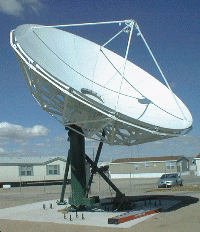
Say "I'm erecting a 7 meter antenna" to most Amateur radio operators and they immediately think there is a new band opening up at 42 mHz. However, it is not an antenna for seven meters, but a seven meter antenna. A salad bowl seven meters in diameter, sitting atop a pedestal and hub thirteen feet above grade. The LNA is located at the focal point another ten feet above that and works at 1.5 to 2.5 gHz.
The bowl, the reflector that is, is constructed of sixteen each wedges and ribs with four support braces that hold the actual antenna assembly--the LNA, duplexer, antenna element--at the focal point. Building the whole thing, pedestal, hub, ribs, wedges, drive motors and jack screws, and all the assorted nuts and bolts, is like playing with a giant erector set.
Fifteen to twenty years ago ATS-3 was the satellite of choice for communications between the various Antarctic stations, the Pan-Pacific Education and Communication Experiments and the earth station located at Malabar Florida. There was even a station aboard the Research Vessel-Icebreaker Polar Duke. One voice channel and one duplex data channel at 2400 to 4800 baud was the usual service and all the users had to take turns according to a complex daily/weekly schedule.
In recent years parts of the Antarctic Programme and P-Sat have migrated
to GOES-3
in order to gain greater bandwidth and data rates. GOES-3 also provides
for multiple simultaneous users. The bandwidth available permits video
conferences. In order to make these normally stationary satellites visible
to South Pole they are migrated into orbits tilted a few degrees away from
the usual equatorial plane. This results in the satellite's apparent motion
describing a sort of figure "8" pattern. From South Pole GOES-3 is visible
for a few hours a day as they see just the top curve of that "8" pattern.
From American Samoa GOES-3 moves from near the horizon to almost overhead
each day and will give the steering motors a lot of exercise.
This particular project consisted of obtaining and refurbishing seven meter antennae for sites in American Samoa and Kokee Hawaii. Each one included assembling all the hardware, testing steering motors and antenna controller, the RF equipment for up and down links all the way to the customer interface. Final acceptance tests included a video conference between the antenna assembly barn in the South Valley of Albuquerque and the PeaceSat offices at the University of Hawaii.
Then we took the first one all apart and packed everything into a 40-foot millvan for shipping to Samoa. The second one will be shipped to Kokee later in September.
The assembly is built to withstand winds up to 150 mph when the antenna is parked pointed straight up in its stowed position.
When the antenna is stowed the bowl is quite a fine place for sun bathing.
--30--

Back to ajo
Copyright © 2003, A.J.Oxton, The Cat Drag'd Inn ![]()